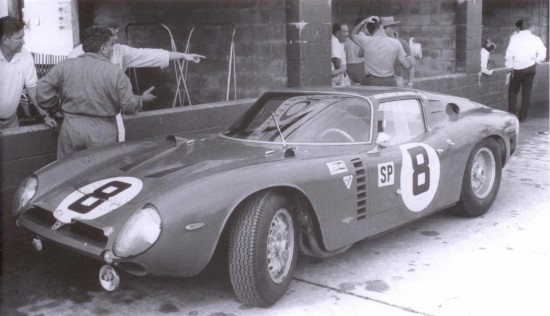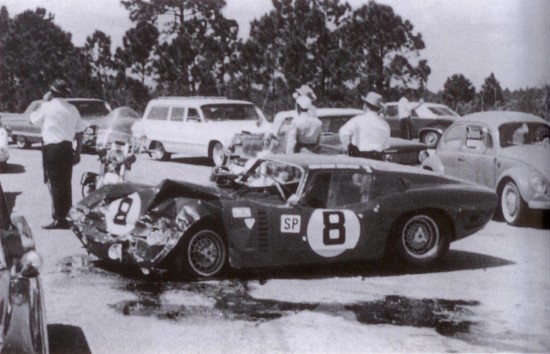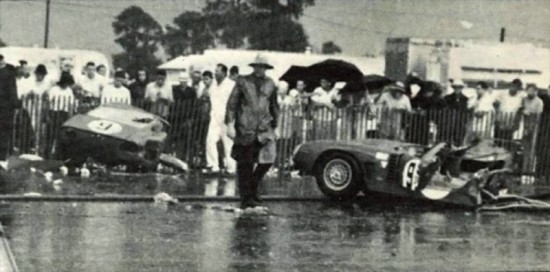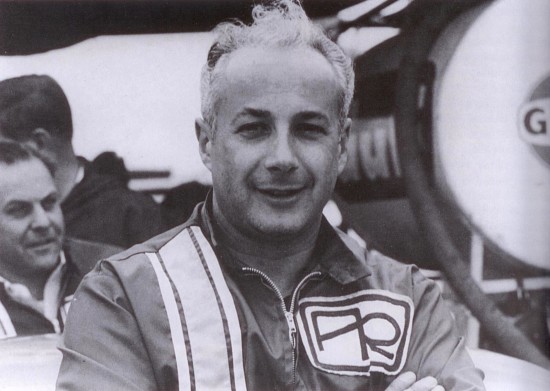by C. Rino Argento
The next few days were busy, very busy ones doing all the things that one has to do preparing for a race of that length: final gears had to be selected because of the tracks long straights, tire pressures had to be determined, suspensions set (Goodyear was helping a lot), fuel consumption had to be determined, pit stops had to be scheduled, the pit area prepared, the tools, the spares, the gas nozzles, etc. had to be readied.
I don’t know what Giotto told his drivers (Moser and Casoni) but I instructed mine to get familiar – as familiar as possible — with the cars potential and idiosyncrasies and to arrive to a comfortable (the magic word) speed that would allow us to finish the race.
Somewhere I must still have the lap times we managed to achieve during the practice sessions, both in daytime and after dark, but I just don’t remember where they are now. We were, anyway, two or 3 seconds off the pace set by the fastest cars but we did not push too hard and we had plenty in reserve for a long twelve-hour race.
Brake fluid controversy
We had a little controversy, which was to have serious consequences about the type of brake fluid to use. Giotto Bizzarrini insisted on the type that Dunlop, the disc brake manufacturer, recommended but I insisted on a different type that was special for racing and with a much higher boiling point. (Dunlop, by the way, was the first company to develop disc brakes but later sold the whole business to Girling which, in turn, developed and produced disc brakes and rotors for just about every car and truck until everybody got into the act and until Kelsey-Hayes solved the rotor distortion and fading problems by coming out with the ventilated rotors that everybody uses today).
This type of Castrol brake fluid was not easy to find and we did not have any so Charlie Rainville and I went to “Goldfinger”. Goldfinger was Art Swanson, whose father had invented the TV dinners that everyone knows. When he sold the company, Art was blessed with enough money to buy something “good” like a 250LM Ferrari every year, race it at Sebring and then spend his Summers in Europe catching the other races in the Championship Series like Targa Florio, and Monza, etc. True to form, Art’s mechanic showed up at our pit not with a can but a whole case of the right brake fluid. Charlie and I filled the circuit of our car No. 9 but the other car went with the wrong (Dunlop) type.
The most important thing was that my drivers were very pleased with the car, its performance and handling. The drivers of the other car (Moser and Casoni) had driven it before in competition so they were already familiar with it. We had hopes!
March 27, 1965 dawned bright and sunny and I got up at 5:00AM to get the truck and avoid the long line of the 60 to 70 thousand spectators going to the race and also try to get some breakfast. By 1965 Sebring had become a big thing and there were shops selling every kind of souvenirs, a huge tent with a NASCAR type assembly line of chicken, all the major car manufacturers had tents and displays, and the line of hay bales had been replaced by a concrete block wall.
Were we nervous? Of course we were but the cars looked good, the drivers were ready, our pit was organized with the spare tires, brake pads, motor oil and everything else in place.
The race begins
After the marching bands, the National Anthem, the speeches, and with the noise of a half dozen helicopters overhead, at 10:00 o’clock Mr. Ullman finally dropped the flag and the pilots, Rainville in No. 9 and Moser in No. 8 for our team, ran across the track in the classic Le Mans type start and they were off with no incidents or stalls.
In those days Joe Lane, who was the chief scorer of this race, with a special building on the curve before the pit straight housing all his helpers, used to print out and distribute to all the teams the standings of all the cars and other useful information every hour. I wish I knew what happened to mine but let me just say that after the first hour our cars were doing just fine in eighth and tenth place. Jim Hall’s Chaparral, with its oversized rear wing, was setting a torrid pace. Naturally, all the 250LM Ferraris were after him as if this was a sprint race of an hour or so, then came the Cobras, the Porsches, the Alfas, the Austin Healeys, and all the cars in the slower categories, and we were up there with the leaders.
At about 11 o’clock, one hour into the race, things began to settle down. The slower, smaller displacement cars had been lapped once or twice, some cars had already been retired for one reason or another, and “us Americans” in our pits were wondering exactly what Mr. Ugolini was doing there. Probably invited by Bizzarrini to come down because he did not know what kind of organization we could provide, he was a tried and true manager of major teams, but I believe he was lost amongst people who, thanks to the SCCA, raced every third week or so. To me he looked like a typical civil servant of any nationality, very able to carry out orders but without a spark of initiative.
And it was one hour into the race at the 17th lap that, while I was at the pit wall giving Rainville his position and lap time, I heard Sandy (Rainville) yell that our No. 8 car with Moser had not come around!
When you are in a race, in the pits, and you have a car running out there, there is nothing that terrifies you more than news like that! When your car does not come around when due there could be all kinds of causes: a spin, delay due to slow traffic ahead of you, an off road excursion, or something mechanical like engine problems, a tire, transmission, something electrical- or it could be something a lot worse!
No. 8 is off track
1965 was way before the communication age so it took some time to learn from the race marshals and from the P.A. system that the car had gone off course in a big way but that the driver was O.K. What had happened was that the car’s Dunlop brake fluid had boiled away – literally evaporated – so driver Moser could not stop the car. With no brakes whatsoever, the car just kept going and going and going -off the course and into a spectators access road where it hit a VW Comby loaded with people in line to come to the race. The front of the car had been badly damaged by hitting assorted barriers and fences and finally the VW.
Fortunately, neither Moser nor any of the occupants of the VW were hurt and the VW was not badly damaged. The police and firemen towed the car away from the public road and exposure to souvenir hunters. I sent somebody to guard it anyway and it was my duty to visit Moser at the hospital tent at the end of the pit straight. He had only some scratches on his face and hands but he was still dazed, and with the look of a person who, for a brief instant, had seen his Maker! Sometime later, when he had been checked out and released, he was sent back to his hotel and from there to the airport for the trip home. And co-driver Casoni, who had traveled thousands of miles and did not even get a chance to drive a lap in competition, also left.
So, we are one hour into the race and we are down to one car. Some color comes back to the face of Giotto and De La Graviere also considering that the accident could have been a lot – and I mean a lot – worse.
Charlie is running nice and steady with a minimum of time variation between laps and, as predictable, some cars fell by the wayside. A couple of Ferraris drop out for one reason or another, ditto for a Ford GT, and a couple of Cobras, all cars being in direct competition with ours. No problems with our tire change and change of drivers and Gammino in a couple of laps finds his pace, which matches Charlie’s.
“The car is going well,” says Charlie at the end of his stint at the wheel and traffic is thinning out with retirements. He can keep up with the best and there are no problems. The tires show perfect wear, which means a good suspension set-up and gas consumption, is as anticipated. Water temperature, oil pressure and temperature, electrical system, and just about everything else with the car is O.K.
Another change of driver and tires, Charlie takes over again, and the combination of a nice, steady drive and other cars retiring moves us up in the standings. Charlie, per my instructions, begins to force the pace just a little bit, just to worry the competition and force them to do the same. Before you know it, our car is way ahead of a lot of cars in its class and, I believe, we are in 6th or 7th place overall with another 5 hours to go!
It is only natural that there is a good feeling in our pits. Balchowsky is impressed with the car’s performance and he keeps an eye on everything, as he always did, and Mr. Michelmore is equally impressed and he is thinking and talking about sales potential with Ing. Bizzarrini. Gammino is enthusiastic about the whole thing and starts talking with Giotto about building a CAN-AM type car for him for the next racing season – a car that as all you Bizzarrini fans know will be built – the P538.
Rain is coming
The next stop to change tires, drivers, and the brake pads was scheduled for five o’clock. Charlie brought the car in and everything went as planned until we had to change the brake pads. The calipers had distorted somewhat because if the intense heat and there was no way to get the old pads out; the Italian mechanic, Libero, Max, Charlie and myself tried to get them out with every tool available, and the minutes of our advantage over other cars had slipped away. We finally decided to take the entire caliper assemblies out and remove them on the bench. We did that but it meant reconnecting the brake lines and bleeding them and that meant more and more time lost. Gammino finally got back in the car and away he went.
In the meantime the sky had turned almost black with low clouds hovering over the track; no lightning strikes or thunder – just dark clouds loaded with rain. And then the rains came! It was a tropical rain that literally came down in sheets -something I had never seen before in my life. In minutes the track had six inches of rainwater. The cockpits of the open cars filled with water with some drivers keeping one door open to let some of the water out. The low front ends of all the cars acted as snow plows producing water plumes and sending water pouring inside the cockpits. Cars spun out all over the track, got stuck in the mud, and got lost because the drivers could not see where they were going. Lap times went from 3 minutes and change to 15 minutes and more.
In the pits the situation was complete chaos: tents, tarps, and covers collapses, electrical tools shorted, spare tires were floating down pit lane, and lap charts disappeared in the wind. Cars were coming in to have all kinds of electrical problems fixed and to open the doors to let the water drain out. The spectators actually fared better than anybody else as they could run back to their cars, campers, and trailers and wait the storm out.
No. 9 aquaplanes, hits the pedestrian bridge and splits in two
Fully refuled and with new tires and brakes and some motor oil added Mike Gammino finally got underway at full speed trying to make up some of the lost time especially to the open cars which were suffering more than the coupes in the deluge. One lap, two laps at the highest rate of speed that conditions allowed, but at the third passage in front of our pits the car started to aquaplane and went out of control. It hit the support for the pedestrian bridge, a solid steel beam, sideways and the car was split into two pieces right behind the driver’s seat with a horrible sound!
This crash was right on the pit straight, right in front of everybody, and a cry of anguish rose from the whole pit lane. I just could not move frozen in place by what I had just seen, but a couple of us and Mike’s father and Uncle ran to the pedestrian bridge.
They brought Mike, who had only a slight bump on one knee and looked like nothing had happened. It turns out that when the car split in two right behind him he just opened the door and stepped out! It was raining too hard for anything to catch fire, fortunately, and the two pieces had come to rest on the track without hitting any of the spectators.
I believe that this was as close to a miracle as you can get and the fact that we, as a team, had lost our second car and any hopes of getting something out of this race was secondary to the fact that we had Mike with us alive and well and in one piece.
In the meantime, as rapidly as it had arrived, the storm had disappeared and the sun was trying to shine through the remaining clouds while a breeze was drying out the track. Jim Hall’s Chaparral was running as fast as before without any problems and it would eventually win by four laps over the Ford GT40 and six laps ahead of the Ferrari of Piper and Maggs.
As soon as all the people who had come over to our pits to congratulate Mike Gammino and to make sure that he was indeed O.K. and after all the press and TV and camera people had left, we were facing the full reality of our situation: some 20 people had traveled thousands of miles, they had set aside their work and professions, there had been phone calls, rented cars, hotels and motels, paperwork, preparations, tools and spares, etc., etc. and it had all been for nothing and both cars had been totaled.
That’s when something remarkable happened. Fully aware of Giotto’s financial situation, everybody set in motion something to help him not out of pity but rather out of sincere admiration for an excellent engineer, a good car builder, and a good person.
Thinking about the next car and the next race
“He is a good man and a good car builder,” said Michelmore “and I’m going to help him” and the two got together to discuss a sales plan that brought some smile on Giotto’s face. Mike Gammino made it definite that he wanted a CAN-AM car built as soon as possible and Max Balchowsky made an arrangement to take what was left of the two wrecked cars to his California shop and reconstruct them into one serviceable and salable car.
Giotto might not have shown the characteristic fast thinking of your “typical” American entrepreneur and he certainly was not used to the vast and fast availability of products and services, as we are accustomed to in this country. But he had made a tremendous impression upon everyone who came in contact with him and, when two days before the race, he rolled up his sleeves and singlehandedly changed the rack and pinion of the rear end of a competitor’s Ferrari – well, that did not go unnoticed along with the fact that he refused any sort of compensation.
On the following Sunday we were all at the Pontiac garage, looking at what was left of the two cars, selling some of the spares (and for some we never received payment) and saying goodbye. My tentative pre-Race plan had been to take one of the cars still dirty from the race to the forthcoming New York Auto Show for publicity purposes but, obviously, that was now impossible. But we all promised to start again after a natural period of reconstruction of the Grifo’s activities.
I took the Michelmores and Max Balchowsky to the Tampa Airport where Max decided to fly directly to Los Angeles instead of going to New Orleans then flying to L.A. with the Miclelmores. He had to get back to his shop as soon as possible and organize the transport of the two wrecks.
I flew back to Detroit. The following morning Balchowsky called me with more truly horrible news: the Michelmores arrived at New Orleans and they had taken off in their plane to get back home, bad weather notwithstanding. The plane took off but crashed right outside the airport and there were no survivors!
This was the end of a terrible week and the pain was unbearable for me, the organizer of this adventure! In great part because of my initiative and planning all these people had congregated at Sebring for what was supposed to be a fun, interesting, successful, and profitable race and it turned out to be a human and material disaster!
Postscript
Three or four months later I received a call from the FBI. The Customs office had caught up with their paperwork and it showed that I had received two cars and a big box of spare parts on a “Transit Permit” but there was no proof that they had gone back to Italy where they had come from. I explained what had happened and mailed them copies of the Florida newspapers, which described “officially” what had happened with all the details and photos. I never heard from them again!
Some months after the race Max Balchowsky sent me two photocopies of the “new” car being reconstructed at his Hollywood Sports Cars shop from the two wrecks. Unfortunately, the quality of these copies is poor but to my knowledge no other photos of this project in process exist. Despite the poor quality the two most important aspects of these photos are clear:
1) the reconstruction is well along, and
2) the race numbers 8 and 9 assigned to the two cars for the Sebring Race can be clearly seen
I do not know whether the car was actually completed nor its subsequent fate.
Does anyone know what happened to this car?
This text of this article was originally published in the Spring 2001 issue of The Griffon (The magazine of the Iso & Bizzarrini Owner’s Club). The author, C. Rino Argento, was instrumental in organizing the race activities for Giotto Bizzarrini at the 12 Hours of Sebring in 1965.







Thanks for the great story. It has every element of a Hollywood movie.
In answer to the question,”I do not know whether the car was actually completed nor its subsequent fate.
Does anyone know what happened to this car?”
I believe the answer is here:
https://www.youtube.com/watch?v=ZoBFcV0WyWw
Regards,
Anthony
Anthony,
A lot of people have sent that video to me thinking they have found the lost Iso/Bizzarrini race car. However, that is not it.
Mike,
As you know I have been looking for this car for a number of years. In My Quest I was able to find the original engine in southern California. I have tracked the car down to still being in the SoCal area as late as the early 70’s with multiple owners, then it disappears. Because the car was restored with a unique nose and no pictures have ever been seen since the repair it is my guess that the car remains a barn find some where in the SoCal area. I have the engine now we just need the car. Any help appreciated locating this piece of history.
Mike Clarke
i worked on that car, repaired the charging system, it ended up in tarzana california, that was in the early 60’s,,,, i remember ralph, the owner talking about max balchowsky… car was driveable.